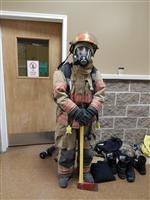Protective Services
Page Navigation
- Erie High School
- Overview
-
Protective ServicesCIP Code: 43.9999Pathway: Human ServicesInstructor: Nicholas BanisterCertifications: OSHA 10, S/P2, CPR/First Aid/AED, NIMS 100, NIMS 200, NIMS 700, NIMS 800, MTDS, MOAB, OCAT, PATH, PPBT, EMT
If you are community-minded, protective of those around you, and concerned for the rights of others, then public safety would be a great career choice. Our Protective Services program focuses on the techniques, methods and procedures used in criminal justice as well as rescue and emergency response. You will get classroom and practical experience to jump start your career as a police officer, firefighter, or emergency medical technician. Your coursework will get you ready mentally and physically to enter the police academy, firefighter school, or other public safety programs. Your studies also will prepare to earn your First-Aid, CPR, and EMT certifications. In addition, we have added the content needed to prepare students to take the firefighter's exam needed for employment with the Erie Fire Department.
Introduction - Program of Study
This program of study prepares students for careers insecurityor law enforcement, firefighting, and emergency medical services. There are many certifications and clearances required for careers in these areas.
Security guards, also called security officers, patrol and inspect property to protect against fire, theft, vandalism, terrorism, and illegal activity. They protect their employer's property, enforce laws on the property, deter criminal activity, and investigate other problems. Security guards write comprehensive reports outlining their observations and activities during their assigned shifts. They also may interview witnesses or victims, prepare case reports, and testify in court.
In department stores, guards protect people, records, merchandise, money, and equipment. They often work with undercover store detectives to prevent theft by customers or employees, and help apprehend shoplifting suspects prior to the arrival of the police.
Gaming surveillance officers act as security agents for casino employees, managers, and patrons. Using primarily audio and video equipment in an observation room, they observe casino operations for irregular activities, such as cheating or theft, and monitor compliance with rules, regulations, and laws.
Firefighters help protect the public againstdanger by responding to fires and a variety of other emergencies. Although they extinguishfires, firefighters may frequently respond to other emergencies. They are often the first emergency personnel at the scene of a traffic accident or medical emergency and may be called upon to treat injuries or perform other vital functions.
People's lives often depend on the quick reaction and competent care of emergency medical technicians (EMTs). Incidents as varied as automobile accidents, heart attacks, slips and falls, childbirth, and gunshot wounds require immediate medical attention. EMTs provide this vital service as they care for and transport the sick or injured to a medical facility.
Police officers maintain public safety by providing order, enforcing motor vehicle and criminal laws, and protecting people and property. Police officers investigate traffic accidents, robberies, and other crimes against society. They document findings of their investigations and often testify in court.
Specialized types of law enforcement officers include transit and railroad police, ski patrol officers, and animal control workers. Each of these occupations use generally accepted principles of law enforcement. For example, documentation of infractions or crimes, investigative procedures, methods of obtaining information or evidence, and enforcement of laws or ordinances are important ingredients of each position.
Assumptions of this Program of Study
High quality programs should meet the following standards:
1. Promote positive working relationships.
2. Implement a curriculum that fosters all areas of skill development
3. Use appropriate and effective teaching approaches.
4. Provide ongoing assessments of student progress.
5. Employ and support qualified teaching staff.
6. Establish and maintain relationships and use resources of the community.
7. Provide a safe and healthy learning environment.
8. Implement strong program organization and supervision policies that result in high quality teaching and learning.
9. Integrate academic skills and aptitudes necessary for postsecondary education, gainful employment and a foundation of lifelong learning.
CIP Code 43.9999 Homeland Security, Law Enforcement, Firefighting and Related Protective Services
This is an instructional program that prepares individuals to apply technical knowledge and skills required to perform entrylevel duties as a police officer, fire fighter, paramedic and other safety services. This program stresses the techniques, methods and procedures peculiar to the areas of criminal justice and fire protection especially in emergency and disaster situations. Physical development and self-confidence skills are emphasized due to the nature of the specific occupations. In addition to the application of mathematics, communication, science and physics, students receive training in social and psychological skills, map reading, vehicle and equipment operations, the judicial system, pre-hospital emergency medical care and appropriate emergency assessment, treatment and communication.



